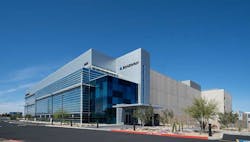Ecosystems and Edge: The Data Center as a Transactional Marketplace
In this edition of Voices of the Industry, Mark Lewis, Senior Director Ecosystem Development, Iron Mountain Data Centers, discusses how the growing demand for interconnection between customers is driving change at the edge in the data center industry.
Mark Lewis, Senior Director Ecosystem Development, Iron Mountain
There’s been a lot of buzz about data center ecosystems and the data center as a transactional marketplace.
In the past, data centers ensured space and power, providing customers direct connections to multiple networks and cloud providers. For the most part, customers didn’t interact with each other.
But that has changed, and central to that change is interconnection between customers. Today’s data center ecosystems look less like an apartment filled with strangers and more like a house whose inhabitants interact with each other for the benefit of all.
This ecosystem is a mutually beneficial environment where businesses come together to enable each other’s growth. It’s a community within the data center, but also a community across a footprint of data centers.
There are three components to an ecosystem — IT service providers, connectivity providers and enterprises. Together, they create an environment where all three can mutually benefit, find growth, and support each other’s development.
In a vendor-neutral, interconnected data center, cloud platforms, network providers, telecoms and enterprises can seamlessly connect and exchange traffic. When customers can connect directly to networks and cloud providers in their own colocation environment, it lowers costs. It also reduces latency, improves security and increases performance.
Transactional Marketplace
Forward-looking colocation businesses have been building in-house marketplaces to nurture these ecosystems for years. This provides a rich mix of applications, services, partners, and clouds that are at the heart of new service development and can simplify and accelerate a customer’s business. Now that enterprise IT architectures are becoming more distributed and interconnection has become more pervasive, these ecosystems can provide vital business agility and supplier choice.
Transactional driven ecosystems are the fundamental value centers of business growth in a digital, global economy. A good example of how this is used is in the gaming industry. Gaming has changed a lot in the last decade. It is now cloud driven and multi-device.
Gaming platforms require high levels of compute and colocation offers an excellent location for this. However, the compute needs to be connected to high performance connectivity, and latency must be low. The connections need to be stable, otherwise, it kills the gaming experience.
In addition, gaming companies need to access payment providers, gateways and billing engines.
Customer accounts must be kept secure, and gameplay needs to be monitored regularly for bad behavior.
This needs to be delivered globally and in milliseconds. Alongside that, the gaming platform needs to manage profitability, which means they need to turn up some suppliers, turn down other suppliers at different times, and they need to be able to do this rapidly and globally. They need to develop new functionality for their own platforms, and must manage sales, marketing, and production. The data from game playing is valuable to advertising partners. This data can be analyzed in flight or ingested to big data platforms for deeper insight mining.
So, to maintain growth, a gaming platform requires a large ecosystem of partners, suppliers, and service providers. This is easier to achieve at lower cost and with greater security if you do it within the ecosystem of a colocation data center facility.
How APIs Drive Ecosystem Value
The exploding growth in APIs over the past decade has highlighted the importance businesses are placing on interconnecting their platforms and workloads. Secure, compliant data center platforms that can reach from edge-to-core-to-cloud to bring diverse sectors together and help simplify the interconnection between them.
APIs are strong indicators of digital economies. In 2008, there were around 1,000 publicly available APIs. Today, there are 22,000 APIs available and growing at a rate of roughly 220 APIs every year.
Transactions across digital ecosystems require APIs. APIs provide the glue, the access, the connection between different platforms, and services. The growing number of APIs indicates that there is significant growth and health in the wider ecosystem because it shows the diversity of transactions that companies have with each other.
Ecosystems grow best when they are built on open APIs. An open platform gives the ecosystem’s members more choice and flexibility over how and when to connect. Open APIs require an open platform, and more services transacting together creates more growth. As platforms interconnect with each other, data must pass between different applications, different providers, and different locations, and API is the core to making that happen.
One area where we’ll see even more growth in the future for APIs is around sensors and IoT devices, which will likely generate large volumes of data. Since data only has value when it’s used, or transacted, it’s likely that connecting to these data streams, analyzing their content and extracting their insights will require further interconnection across the ecosystem.
APIs are important because we need to connect these sensors and devices to edge and core systems and workloads that allow that data to have value. In the future, the growth in endpoints, sensors and devices of the IoT world will mirror a growth in APIs across different applications connecting those data points.
Register today, at no cost, for the webinar, “Ecosystems & the Edge: Where the Data Center Becomes a Transactional Marketplace,” scheduled for October 7th at 2 p.m. EST.
Transacting data generated by IoT devices and sensors needs careful handling. For regulatory reasons, some data will stay locally in the metro and need secure compliant storage. Other data will be monetized close to its source and need to be transacted at high speed. This is likely to drive a proliferation in new applications and services requiring API connections.
Ecosystem and Edge
Ecosystem is critically important to edge infrastructure. Over the next few years, we’ll see a significant increase in the amount of data generated through a wide variety of use cases. The volume of this data is important, but the value in that data is realized when it’s monetized or transacted between applications or platforms. Having access to a global ecosystem of partners, suppliers and service providers gives the widest possible opportunity for innovation and business growth.
Connectivity performance is key at the edge because of the large volume and velocity of data likely to be generated. Lowering transit costs, increasing local metro traffic volumes and optimizing application user experience represent benefits from deploying closer to the sources and consumers of data.
This could drive an expansion in local peering and internet exchanges as well as the establishment of metro level meet me rooms. For larger carriers, it’s an opportunity to extend services directly into the metro.
Mobile operators are already trialing dedicated and distributed multi-access edge networks running over 5G supported by services such as AWS Wavelength. Local aggregation of these services via neutral edge data centers can speed up deployment and ensure future expansion capacity.
As edge deployments grow, we’ll see a different layer of data centers develop. Edge data centers are likely to be smaller and in new markets closer to city centers, close to the points at which data is generated. They will complement the capacity and interconnection rich core data centers we have today.
The ecosystem is valuable to the edge as deployments and workloads evolve. More and more customers are taking advantage of data center ecosystems to grow and create more value. At the same time, they are realizing that they have new requirements in new places and need edge facilities that can drive transactions and share data via APIs. Today, near edge locations fill up quickly and what was the edge just a year or so ago has become the ‘new core’.
There are exciting times ahead in the data center industry, and a vibrant data center ecosystem will enable future success for data center customers.
Mark Lewis is Senior Director Ecosystem Development at Iron Mountain Data Centers. Read more at Ecosystems & the Edge: Where the Data Center Becomes a Transactional Marketplace, a special report by Data Center Frontier.



